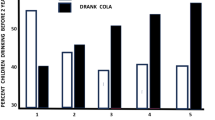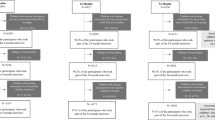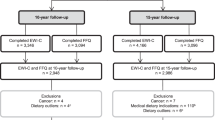Abstract
Background:
The family food environment (FFE) is likely to exert important influences on young children's eating. Examination of multiple aspects of the FFE may provide useful insights regarding which of these might most effectively be targeted to prevent childhood obesity.
Objective:
To assess the associations between the FFE and a range of obesity-promoting dietary behaviors in 5–6-year-old children.
Design:
Cross-sectional study.
Subjects:
Five hundred and sixty families sampled from three socio-economically distinct areas.
Measurements:
Predictors included parental perceptions of their child's diet, food availability, child feeding practices, parental modeling of eating and food preparation and television (TV) exposure. Dietary outcomes included energy intake, vegetable, sweet snack, savory snack and high-energy (non-dairy) fluid consumption.
Results:
Multiple linear regression analyses, adjusted for all other predictor variables and maternal education, showed that several aspects of the FFE were associated with dietary outcomes likely to promote fatness in 5–6-year-old children. For example, increased TV viewing time was associated with increased index of energy intake, increased sweet snack and high-energy drink consumption, and deceased vegetable intake. In addition, parent's increased confidence in the adequacy of their child's diet was associated with increased consumption of sweet and savory snacks and decreased vegetable consumption.
Conclusion:
This study substantially extends previous research in the area, providing important insights with which to guide family-based obesity prevention strategies.
This is a preview of subscription content, access via your institution
Access options
Subscribe to this journal
Receive 12 print issues and online access
$259.00 per year
only $21.58 per issue
Buy this article
- Purchase on Springer Link
- Instant access to full article PDF
Prices may be subject to local taxes which are calculated during checkout

Similar content being viewed by others

References
Lobstein T, Baur L, Uauy R, TaskForce IIO . Obesity in children and young people: a crisis in public health. Obes Rev 2004; 5 (Suppl 1): 4–104.
Hesketh K, Wake M, Waters E, Carlin J, Crawford D . Stability of body mass index in Australian children: a prospective cohort study across the middle childhood years. Public Health Nutr 2003; 7: 303–309.
Dietz W . Health consequences of obesity in youth: childhood predictors of adult disease. Pediatrics 1998; 101: 518–525.
World Health Organization. Obesity: preventing and managing the global epidemic: Report of the WHO Consultation. World Health Organization: Geneva, 1999. WHO Technical Report Series 894.
Krebs Smith SM, Cook A, Subar AF, Cleveland L, Friday J, Kahle LL . Fruit and vegetable intakes of children and adolescents in the United States. Arch Pediatr Adolesc Med 1996; 150: 81–86.
Gregory J, Collins DL, Davies PSW, Hughes JM, Clarke PC . National Diet and Nurition Survey: Children Aged 1.5–4.5 Years. Report of the Diet and Nutrition Survey. HMSO: London, 1995.
Campbell K, Waters E, O’Meara S, Kelly S, Summerbell C . Interventions for preventing obesity in children. Tae Cochrane Database Syst Rev 2002. 2(CD 001871): The Cochrane Library.
Gibson EL, Wardle J, Watts CJ . Fruit and vegetable consumption, nutritional knowledge and beliefs in mothers and children. Appetite 1998; 31: 205–228.
Gillman MW, Rifas-Shiman SL, Frazier AL, Rockett HR, Camargo Jr CA, Field AE et al. Family dinner and diet quality among older children and adolescents. Arch Fam Med 2000; 9: 235–240.
Birch L, Fisher J . Development of eating behaviors among children and adolescents. Pediatrics 1998; 101: 539.
Taras H, Sallis J, Patterson T, Nader PR, Nelson J . Television's influence on children's diet and physical activity. Dev Behav Pediatr 1989; 10: 176–180.
Campbell K, Crawford D . Family food environments as determinants of preschool aged children's eating behaviours: implication for obesity prevention policy. Austr J Nutr Diet 2001; 58: 19–25.
Fisher JO . Eating in the absence of hunger and overweight in girls from 5 to 7 y of age. Am J Clin Nutr 2002; 76: 226–231.
Birch LL, Fisher JO . Mothers' child-feeding practices influence daughters' eating and weight. Am J Clin Nutr 2000; 71 (5): 1054–1061.
Australian Bureau of Statistics. 1996 Census of Population and Housing: Socio-Economic Indexes for Areas. Commonwealth of Australia: Canberra, 1998.
Australian Bureau of Statistics. National Nutrition Survey 1997. Nutrient Intakes and Physical Measurements. Australian Bureau of Statistics: Canberra, 1998. Report no. 4805.0.
Rolls BJ . The role of energy density in the over-consumption of fat. J Nutr 2000; 130 (2S Suppl): 268S–271S.
Bartko JJ, Carpenter WT . On the methods of theory of reliability. J Nerv Ment Dis 1976; 163: 307–317.
Birch LL, Fisher JO, Grimm-Thomas K, Markey CN, Sawyer R, Johnson SL . Confirmatory factor analysis of the child feeding questionnaire: a measure of parental attitudes, beliefs and practices about child feeding and obesity proneness. Appetite 2001; 36 (3): 201–210.
Kim J . Factor analysis. In: Nie NHHC, Jenkins JG, Steinbrenner K, Bent DH (eds) Statistical Package for the Social Sciences. McGraw-Hill: New York, 1975.
Stata 8 (SE) [Computer program]. Stata Corporation. College Station, 2003.
Crawford PB, Obarzanek E, Schreiber GB, Barrier P, Goldman S, Frederick MM et al. The effects of race, household income, and parental education on nutrient intakes of 9- and 10-year-old girls. NHLBI Growth and Health Study. Ann Epidemiol 1995; 5: 360–368.
SPSS for windows [Computer program]. Release 115.2.1., Chicago IL; SPSS Inc. 2003.
Crespo CJ, Smit E, Troiano RP, Bartlett SJ, Macera CA, Andersen RE . Television watching, energy intake, and obesity in US children: results from the third National Health and Nutrition Examination Survey, 1988–1994. Arch Pediatr Adolesc Med 2001; 155: 360–365.
Giammattei J, Blix G, Marshak HH, Wollitzer AO, Pettitt DJ . Television watching and soft drink consumption: associations with obesity in 11- to 13-year-old schoolchildren. Arch Pediatr Adolesc Med 2003; 157: 882–886.
Boynton-Jarrett R, Thomas TN, Peterson KE, Wiecha J, Sobol AM, Gortmaker SL . Impact of television viewing patterns on fruit and vegetable consumption among adolescents. Pediatrics 2003; 112: 1321–1326.
Borzekowski DL, Robinson TN . The 30-second effect: an experiment revealing the impact of television commercials on food preferences of preschoolers. J Am Diet Assoc 2001; 101: 42–46.
Francis LA, Lee Y, Birch LL . Parental weight status and girls’ television viewing, snacking, and body mass indexes. Obes Res 2003; 11: 143–151.
Coon KA, Goldberg J, Rogers BL, Tucker KL . Relationships between use of television during meals and Children's food consumption patterns. Pediatrics 2001; 107: E7.
Saelens BE, Sallis JF, Nader PR, Broyles SL, Berry CC, Taras HL . Home environmental influences on children's television watching from early to middle childhood. J Dev Behav Pediatr, 2002; 23 (3): 127–132.
Variyam JN, Shim Y, Blaylock J . Consumer misperceptions of diet quality. J Nutr Educ 2001; 33: 314–321.
Lechner L, Brug J, De Vries H . Misconceptions of fruit and vegetable consumption: differences between objective and subjective estimation of intake. J Nutr Educ 1997; 29: 313–320.
Fisher JO, Mitchell DC, Smiciklas-Wright H, Birch LL . Parental influences on young girls’ fruit and vegetable, micronutrient, and fat intakes. J Am Diet Assoc 2002; 101 (1): 58–64.
Birch L, McPhee L, Shoba B, Steinberg L, Krehbiel R . Clean up your plate: effects of child feeding practices on the conditioning of meal size. Learn Motiv 1987; 18: 301–317.
Lee Y, Mitchell DC, Smiciklas-Wright H, Birch LL . Diet quality, nutrient intake, weight status, and feeding environments of girls meeting or exceeding recommendations for total dietary fat of the American Academy of Pediatrics. Pediatrics 2001; 197 (6): E95.
Birch LL, Birch D, Marlin DW, Kramer L . Effects of instrumental consumption on children's food preference. Appetite 1982; 3 (2): 125–134.
Baranowski T, Cullen KW, Baranowski J . Psychosocial correlates of dietary intake: advancing dietary intervention. Annu Rev Nutr 1999; 19: 17–40.
Hu FB, Rimm E, Smith Warner SA, Feskanich D, Stampfer MJ, Ascherio A et al. Reproducibility and validity of dietary patterns assessed with a food-frequency questionnaire. Am J Clin Nutr 1999; 69 (2): 243–249.
Blom L, Lundmark K, Dahlquist G, Persson LA . Estimating children's eating habits. Validity of a questionnaire measuring food frequency compared to a 7-day record. Acta Paediat Scand 1989; 78 (6): 858–864.
Acknowledgements
Karen Campbell conceived, designed and undertook this study and its analysis and writing up. David Crawford supported all aspects of the study conception, development, analysis and writing up. Kylie Ball provided expert advice regarding statistical and analytical approaches to the data, as well as providing substantial input into reviewing the manuscript.We acknowledge the contributions of Dr Michelle Jackson, who was responsible for collection of data in the field; of Ms Alison Carver, the Data Manager of Deakin University's Behavioural Epidemiology Group; of our co-investigators, Dr Karen Cashel, Professor Leanne Birch and Kay Gibbons, all of whom contributed to the planning of the study; and of our co-investigator Professor Tony Worsley for ongoing analytical and conceptual input to this study.
This study was funded by a Diabetes Australia grant. Karen Campbell was supported by the National Health and Medical Research Council and is currently supported by a National Heart Foundation Post-doctoral Fellowship. David Crawford and Kylie Ball are supported jointly by National Health and Medical Research Council and by National Heart Foundation Career Development Awards.
Author information
Authors and Affiliations
Corresponding author
Rights and permissions
About this article
Cite this article
Campbell, K., Crawford, D. & Ball, K. Family food environment and dietary behaviors likely to promote fatness in 5–6 year-old children. Int J Obes 30, 1272–1280 (2006). https://doi.org/10.1038/sj.ijo.0803266
Received:
Revised:
Accepted:
Published:
Issue Date:
DOI: https://doi.org/10.1038/sj.ijo.0803266
Keywords
This article is cited by
-
Reducing sugary drink intake through youth empowerment: results from a pilot-site randomized study
International Journal of Behavioral Nutrition and Physical Activity (2019)
-
The Food4toddlers study - study protocol for a web-based intervention to promote healthy diets for toddlers: a randomized controlled trial
BMC Public Health (2019)
-
Relational space and place and food environments: geographic insights for critical sustainability research
Journal of Environmental Studies and Sciences (2018)
-
Maternal Predictors of Child Dietary Behaviors and Weight Status
Current Nutrition Reports (2018)
-
Food parenting and child snacking: a systematic review
International Journal of Behavioral Nutrition and Physical Activity (2017)


